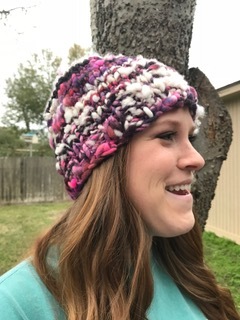Basic Hat Recipe: Knit a Beanie in the round!
By Dayna Mankowski (www.madisonwool.com)
Hats are fun to make –especially with hand spun yarn! No need for a pattern- just 80-100 yds of hand spun, 16 inch circular needles and matching double pointed needles, and a tape measure. You will make your own pattern based on your head size and the fabric you like from your yarn and needles. Hand spun yarn is not necessary, use whatever yarn you would like!
1. Get your yarn and needles ready. For this example, I used handspun from Heather Lightbody from Girl With a Hook (www.girlwithahook.com) and grabbed a size 13, 16 inch circular needle. The yarn is thick with some texture (soft blend of locks and faux cashmere).
2. Knit a swatch: Many are afraid of gauge and swatches- don’t be! This will help you get a great fitting hat. Here is a quick and dirty way to do this: cast on 20 stitches, and knit 6 rows in stockinette stitch (knit a row, purl a row). I liked the fabric I got with this yarn and needle combination- tight but not too tight. If I didn’t like it, I would go up a needle size to make it looser or down a needle size for tighter fabric.
3. Lay your swatch flat and measure how many stitches per four inches. For this example, I had 2 stitches per inch. (about 8 stitches over 4 inches- round up to the nearest stitch)
4. Measure your head: I have a 22 inch head circumference.
5. Calculate the number of stitches to cast on: For this hat, I cast on 44 stitches (22 inch head x 2 stitches per inch=44 stitches). I use a Knit Cast on usually (to save yarn), but Long Tail Cast On or whatever you prefer is fine.
6. Join for Knitting in the Round: Being careful not to twist, join your work in the round. Place a stitch marker at the beginning of the round, or use your tail of cast on to know where the beginning is.
7. Choose your Brim: Knit every round for a roll brim, or do some ribbing for a flat brim. In this example, I did a Knit 2, Purl 2 ribbed brim for 6 rows.
8. Choose your Pattern: For a beanie, you have about 8 inches to get creative! Knit every row (for plain stockinette), alternate knitting and purling each row for garter stitch, try ribbing the whole hat, or cables, etc. Handspun usually looks best plain, but have fun!
9. Decrease your top: For this example, I wanted a fitted beanie, so I knit a total of 6 inches (including the brim). If you would like to go slouchy, knit a total of 8 inches before you decrease.
The Spiral Decrease: (about 2 inches) Switching to double pointed needles when needed for small circumference, decrease the top of the hat as follows: (assuming stockinette stitch used; if different, work in pattern)
Row:
1. *K4, K2 together*
2. Knit
3. *K3, K2 together*
4. Knit
5. *K2, K2 together*
6. Knit
7. *K1, K2 together*
8. K2 together around
Bring yarn tail through remaining stitches securely. Wear your beanie, or add a pom pom if desired!
Photos by Sheryl Means.



